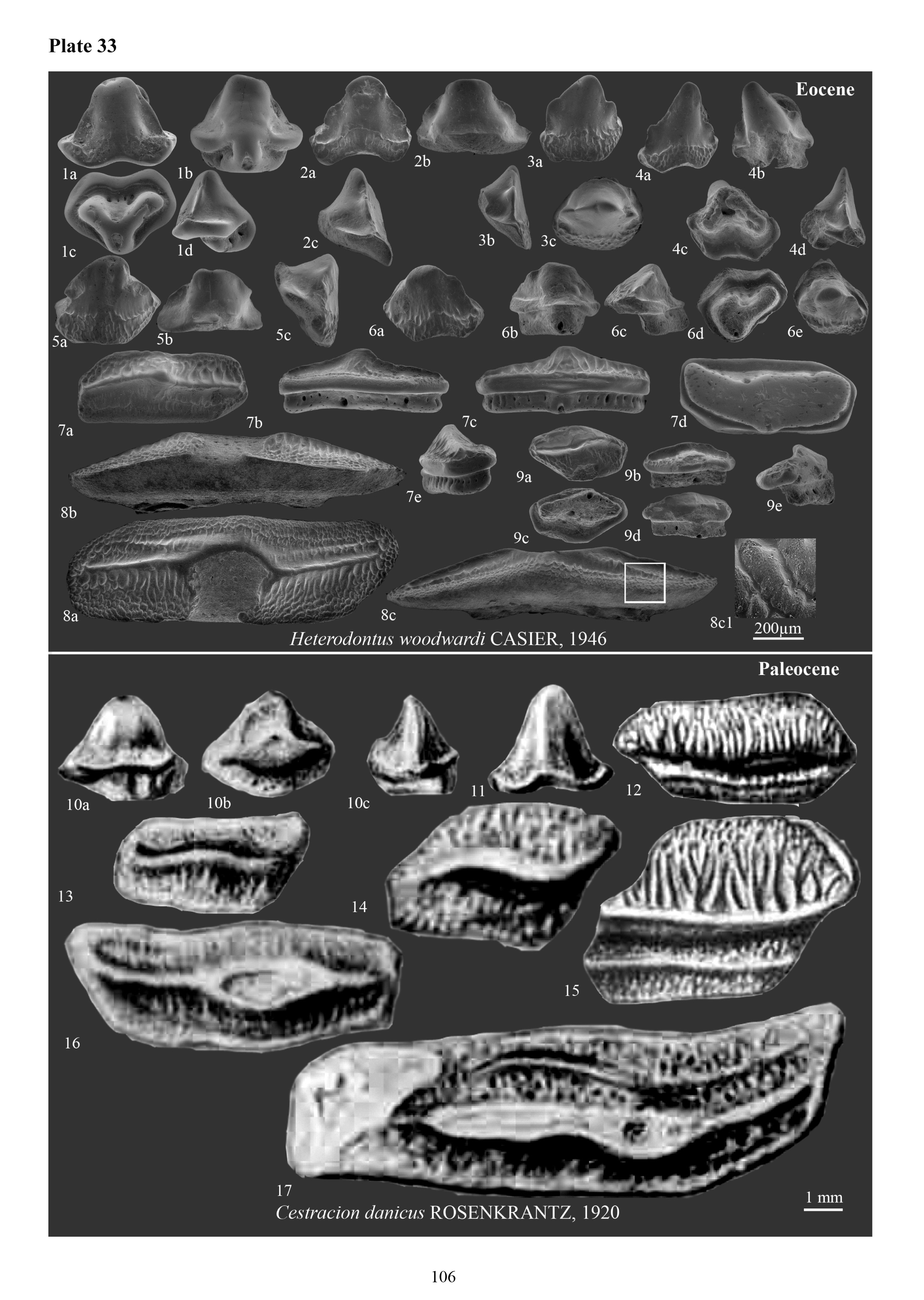
|

|
PALAEONTOS 30Price: members: 34,00 € ; non-members: 37,00 € Hovestadt D.C., 2018, Reassessment and revision of the fossil Heterodontidae (Chondrichthyes: Neoselachii) based on tooth morphology of extant taxa.ISSN: 1377-465473 textpages, 8 textfigures, 3 tables, 44 plates Summary: A comprehensive comparative study of the dental morphology of extant heterodontid sharks has led to new information, placed in Part I. Complementary to REIF’s classic (1976) study, extensive investigation of the dental morphology of the nine species of Heterodontus reveals their exclusive ontogenetic heterodonty. This dental morphology appears to separate Heterodontus into two different morphotypes, one group including the species H. japonicus, H. portusjacksoni and H. zebra and the other H. francisci, H. galeatus, H. mexicanus, H. omanensis, H. quoyi and H. ramalheira. Within these morphotypes a specific distinction is not possible, as is demonstrated by the ontogenetic study. As far as available, the tooth morphology of ontogenetic series is described and illustrated based on isolated teeth as well as on jaw sets of each species, depending on their availability. Information about the locking mechanism of the teeth and a terminology of the Heterodontus attributes is given. All Jurassic, Cretaceous, Paleocene, Eocene, Oligocene, Miocene and Pliocene nominal species referred to the family Heterodontidae in the literature are re-described and re-illustrated as far as possible in Part II; subsequently they are compared with the various types of ontogenetic heterodonty in the extant taxa of both morphotypes. The following fossil species are grouped stratigraphically in ascending order into Heterodontus morphotype 1: Cestracion longidens CHAPMAN & CUDMORE, 1924, Cestracion cainozoicus Chapman & Pritchard 1904, Heterodontus janefirdae CASE, 1980 (one tooth), Strophodus eocenicus TATE, 1894, Heterodontus pineti CASE, 1981, Heterodontus wardenensis CASIER, 1966, Heterodontus woodwardi CASIER, 1946, Cestracion danicus ROSENKRANTZ, 1920 (six teeth), Acrodus humilis LEIDY, 1872, Heterodontus granti CASE & CAPPETTA, 1997 (one tooth), Acrodus rugosus AGASSIZ, 1843 (one tooth), Heterodontus havreensis HERMAN, 1977, Heterodontus lonzeensis HERMAN, 1977, Acrodus polydyctios REUSS, 1846, Gomphodus agassizi REUSS, 1846, Acrodus cretaceous DIXON, 1850, Heterodontobatis paucicarinata LANDEMAINE, 1991, Heterodontus carerens KRIWET, 1999 (three teeth) and Heterodontus polonicus REES, 2005 (four teeth). Morphotype 2 comprises the fossil taxa Heterodontus uscariensis LAURITO MORA, 1999 (six teeth), Acrodus basalduai AMEGHINO, 1906, Acrodus rothi AMEGHINO, 1906, Pseudoacrodus patagonicus AMEGHINO, 1906, Cestracion coleridgensis CHAPMAN, 1918, Heterodontus janefirdae CASE, 1980 (one tooth), Heterodontus elongatus CASE & BORODIN, 2000 (one tooth), Heterodontus sowasheense CASE, 1994 (four teeth), Cestracion vincenti LERICHE, 1905, Heterodontus lerichei CASIER, 1943, Heterodontus maisierensis HERMAN, 1977, Cestracion sulcatus WOODWARD, 1889, Cestracion upnikensis DALINKEVICIUS, 1935 (two teeth), Heterodontus laevis GUINOT, UNDERWOOD, CAPPETTA & WARD, 2013, Cestracion canaliculatus EGERTON, 1850, Heterodontus carerens KRIWET, 1999 (one tooth) and Heterodontus polonicus REES 2005 (one tooth). The fossil species included in morphotypes 1 and 2 are rejected. Some fossil taxa exhibit a character complex that resembles both morphotypes 1 and 2, because they are based on juvenile teeth: Heterodontus uscariensis LAURITO MORA, 1999 (two teeth), Heterodontus granti CASE & CAPPETTA, 1997 (one tooth), Heterodontus sowasheense CASE, 1994 (one tooth) and Acrodus rugosus AGASSIZ, 1843 (one tooth). These species are also rejected. Moreover, Heterodontus creamridgensis CASE, SCHWIMMER, BORODIN & LEGGETT, 2001, Heterodontus granti CASE & CAPPETTA, 1997 (one tooth) and Cestracion upnikensis DALINKEVICIUS, 1935 are considered congeneric with Proheterodontus sylvestris UNDERWOOD & WARD, 2004. Three new heterodontid genera are erected here to accommodate species, whose teeth are morphologically different from those of Heterodontus: Heterodontus boussioni GUINOT, UNDERWOOD, CAPPETTA & WARD, 2013 is reassigned to Protoheterodontus gen. nov., Acrodus semirugosus PLIENINGER, 1847, Hemipristis bidens QUENSTEDT, 1852 and Strophodus semirugosus QUENSTEDT, 1852 are assigned to the genus Procestracion gen. nov., and Heterodontus sarstedtensis THIES, 1983 to Palaeoheterodontus gen. nov. The genus Paracestracion KOKEN, 1911 includes Cestracion falcifer WAGNER, 1857 and Paracestracion bellis UNDERWOOD & WARD, 2004. Taxa that possess teeth dissimilar to morphotypes 1 and 2 and without heterodontid characters are deemed not to belong to the family: Paracestracion pectinatus GUINOT, CAPPETTA, ADNET, 2014, Paracestracion viohli KRIWET, 2008, Wodnika ocoyae JORDAN, 1919, Acrodus emmonsi LEIDY, 1872, Heterodontus elongatus CASE & BORODIN, 2000 and Heterodontus duffini THIES, 1983. Acrodus contortus DAIMERIES, 1892, Platyacrodus unicus AMEGHINO, 1935, Hemipristis bisulcus QUENSTEDT, 1852 and Heterodontus lepagei BIDDLE, 1993 are considered nomina nuda. A phylogenetic analysis and scheme are given illustrating the new approach to heterodontid relationships based on the new dental morphological data. |
|
ORDER INFORMATION:please contact us at: palaeontos@gmail.com |
|